管理学原理英文版——计划planning
- 格式:pptx
- 大小:316.73 KB
- 文档页数:12
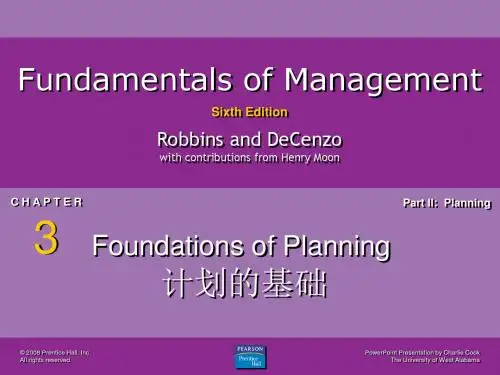
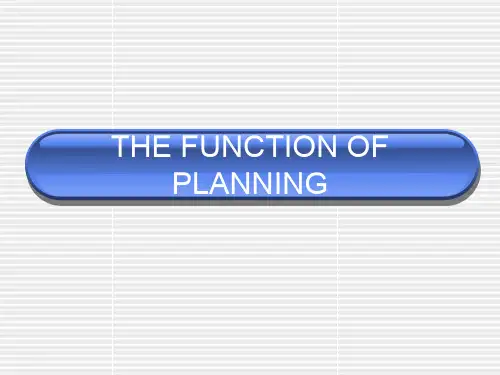
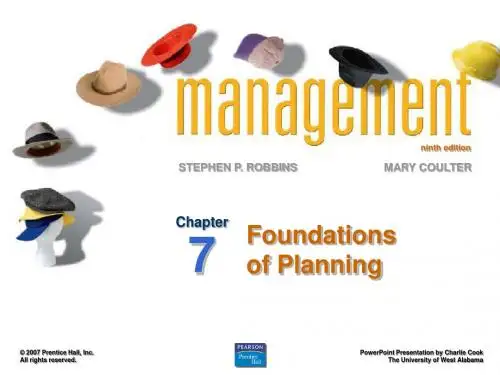

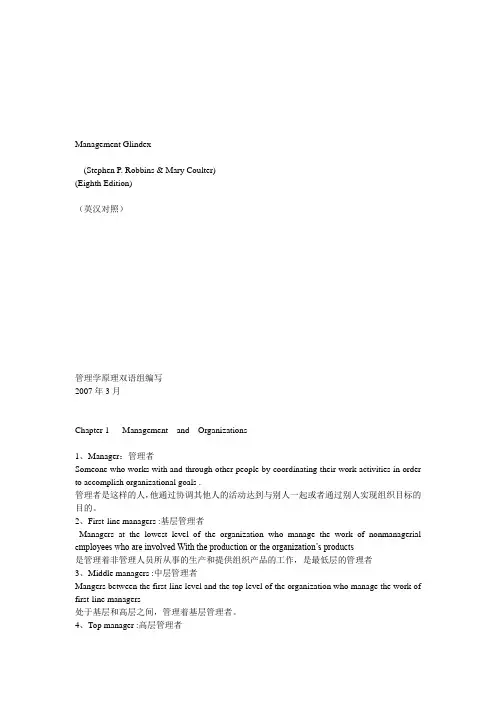
Management Glindex(Stephen P. Robbins & Mary Coulter)(Eighth Edition)(英汉对照)管理学原理双语组编写2007年3月Chapter 1 Management and Organizations1、Manager:管理者Someone who works with and through other people by coordinating their work activities in order to accomplish organizational goals .管理者是这样的人,他通过协调其他人的活动达到与别人一起或者通过别人实现组织目标的目的。
2、First-line managers :基层管理者Managers at the lowest level of the organization who manage the work of nonmanagerial e mployees who are involved With the production or the organization’s products是管理着非管理人员所从事的生产和提供组织产品的工作,是最低层的管理者3、Middle managers :中层管理者Mangers between the first-line level and the top level of the organization who manage the work of first-line managers处于基层和高层之间,管理着基层管理者。
4、Top manager :高层管理者Managers at or near the top level of the organization who are responsible for making organization-wide decisions and establishing the goals and plans that affect the entire organization.处于或接近组织顶层,承担着制定广泛的组织决策,为整个组织制定计划和目标的责任。

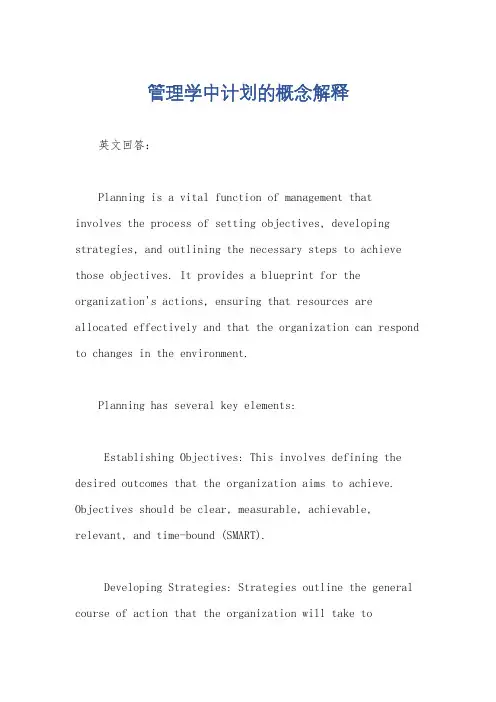
管理学中计划的概念解释英文回答:Planning is a vital function of management that involves the process of setting objectives, developing strategies, and outlining the necessary steps to achieve those objectives. It provides a blueprint for the organization's actions, ensuring that resources are allocated effectively and that the organization can respond to changes in the environment.Planning has several key elements:Establishing Objectives: This involves defining the desired outcomes that the organization aims to achieve. Objectives should be clear, measurable, achievable, relevant, and time-bound (SMART).Developing Strategies: Strategies outline the general course of action that the organization will take toaccomplish its objectives. They involve identifying the target markets, competitive advantage, and methods for achieving growth.Outlining Action Plans: Action plans describe the specific steps and tasks that need to be completed to implement the strategies. They include timelines, responsibilities, and resource requirements.Monitoring and Controlling: This involves comparing actual performance to planned performance and making adjustments as needed. It ensures that the organization stays on track and achieves its objectives.中文回答:计划是管理的一项重要职能,涉及设定目标、制定策略和概述实现目标的必要步骤。
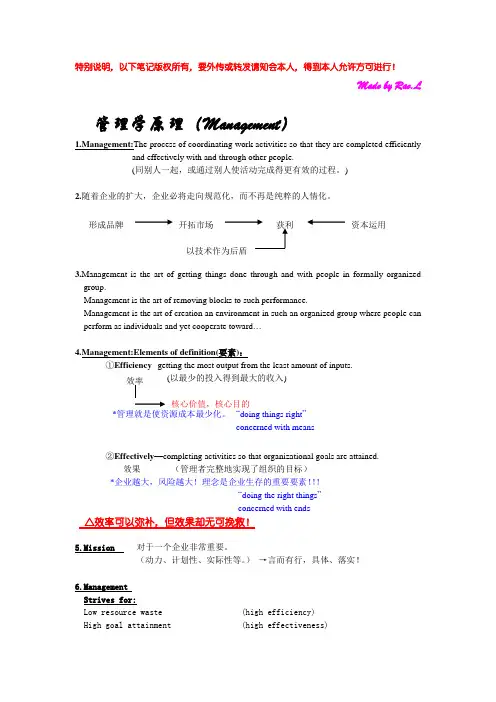
特别说明,以下笔记版权所有,要外传或转发请知会本人,得到本人允许方可进行!Made by Rae.L管理学原理(Management ) 1.Management:The process of coordinating work activities so that they are completed efficientlyand effectively with and through other people.(同别人一起,或通过别人使活动完成得更有效的过程。
)2.随着企业的扩大,企业必将走向规范化,而不再是纯粹的人情化。
3.Management is the art of getting things done through and with people in formally organized group.Management is the art of removing blocks to such performance.Management is the art of creation an environment in such an organized group where people can perform as individuals and yet cooperate toward …4.Management:Elements of definition(要素):①Efficiency --getting the most output from the least amount of inputs.(以最少的投入得到最大的收入)②Effectively —completing activities so that organizational goals are attained.效果 (管理者完整地实现了组织的目标)*企业越大,风险越大!理念是企业生存的重要要素!!!--“doing the right things ”--concerned with ends △效率可以弥补,但效果却无可挽救!5.Mission 对于一个企业非常重要。
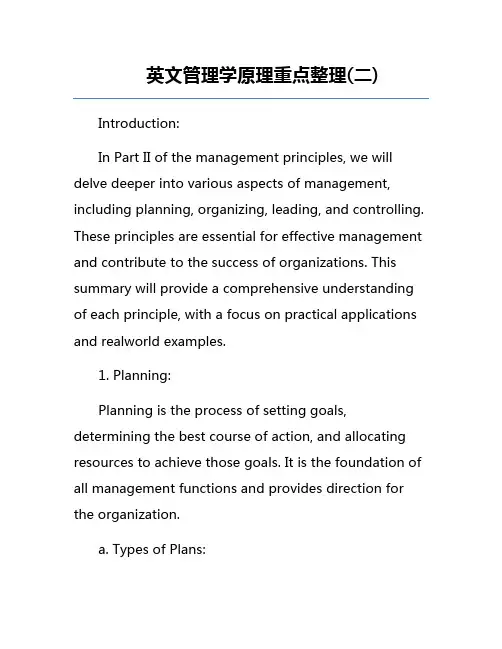
英文管理学原理重点整理(二) Introduction:In Part II of the management principles, we will delve deeper into various aspects of management, including planning, organizing, leading, and controlling. These principles are essential for effective management and contribute to the success of organizations. This summary will provide a comprehensive understanding of each principle, with a focus on practical applications and realworld examples.1. Planning:Planning is the process of setting goals, determining the best course of action, and allocating resources to achieve those goals. It is the foundation of all management functions and provides direction for the organization.a. Types of Plans:Strategic Plans: Longterm plans that define the organization's mission, vision, and objectives.Tactical Plans: Shortterm plans that outline specific actions to achieve strategic goals.Operational Plans: Daytoday plans that guide routine activities and processes.b. Planning Techniques:SWOT Analysis: Analyzing an organization's strengths, weaknesses, opportunities, and threats.Scenario Planning: Developing alternative plans based on different possible future scenarios.Decision Trees: Graphical representation of decisions and their potential outcomes.c. Importance of Planning:Reduces uncertainty: Planning helps anticipate future challenges and allows for proactive decisionmaking.Enhances coordination: It ensures that different departments and individuals work towards common goals.Improves resource allocation: Planning helps in efficient allocation of resources, leading to cost savings and increased productivity.2. Organizing:Organizing involves arranging and structuring the resources and activities of an organization to achieve its goals. It ensures that the right tasks are assigned to the right individuals and departments.a. Organizational Structure:Functional Structure: Departments are grouped based on functions or activities (e.g., marketing, finance).Divisional Structure: Organizational units are created based on products, services, or geographic regions.Matrix Structure: A combination of functional and divisional structures, where employees report to multiple managers.b. Delegation of Authority:Delegation is the process of granting decisionmaking authority to subordinates.It allows managers to focus on strategic issues and empowers employees, increasing their motivation and job satisfaction.c. Span of Control:The number of subordinates a manager can effectively supervise.A wide span of control promotes efficiency, while a narrow span allows for closer supervision and greater control.3. Leading:Leading involves influencing, motivating, and guiding individuals and teams towards the achievement of organizational goals. Effective leadership is crucial for creating a positive work environment and driving performance.a. Leadership Styles:Autocratic Leadership: A leader makes decisions without consulting subordinates.Democratic Leadership: Involves subordinates in decisionmaking and values their input.Transformational Leadership: Inspires and motivates followers to exceed their own selfinterests for the good of the organization.b. Motivation Theories:Maslow's Hierarchy of Needs: Identifies five levels of human needs, from basic physiological needs to selfactualization.Herzberg's TwoFactor Theory: Explains that hygiene factors (e.g., salary, job security) prevent dissatisfaction, while motivators (e.g., recognition, growth opportunities) lead to satisfaction and increased performance.c. Communication:Effective communication is essential for leadership.It involves listening, conveying messages clearly, and ensuring understanding among team members.4. Controlling:Controlling is the process of monitoring, evaluating, and correcting activities to ensure that organizational goals are achieved. It provides feedback on performance and enables continuous improvement.a. Performance Standards:Establishing clear, measurable standards against which performance can be assessed.Standards can be based on quality, quantity, cost, or time.b. Performance Evaluation:Regular assessments of individual and team performance.Methods include performance appraisals, selfassessments, and 360degree feedback.c. Corrective Actions:Taking corrective measures when performance deviates from standards.This may involve additional training, coaching, or changes in processes or resources.Conclusion:This detailed summary of management principles (Part II) provides an indepth understanding of planning, organizing, leading, and controlling. These principles are interconnected and crucial for effectivemanagement. By applying these principles, managers can enhance organizational performance, foster a positive work environment, and achieve strategic goals. Remember, management is both an art and a science, requiring a combination of theoretical knowledge and practical skills.。
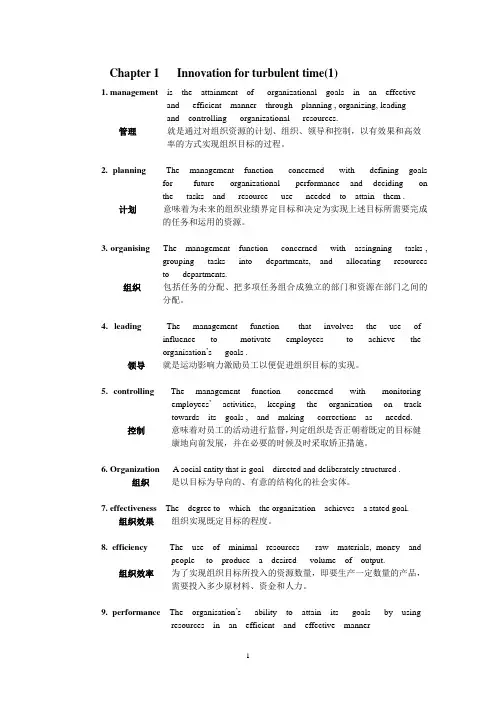
Chapter 1 Innovation for turbulent time(1)1. management is the attainment of organizational goals in an effectiveand efficient manner through planning , organizing, leadingand controlling organizational resources.管理就是通过对组织资源的计划、组织、领导和控制,以有效果和高效率的方式实现组织目标的过程。
2. planning The management function concerned with defining goalsfor future organizational performance and deciding onthe tasks and resource use needed to attain them .计划意味着为未来的组织业绩界定目标和决定为实现上述目标所需要完成的任务和运用的资源。
3. organising The management function concerned with assingning tasks ,grouping tasks into departments, and allocating resourcesto departments.组织包括任务的分配、把多项任务组合成独立的部门和资源在部门之间的分配。
4. leading The management function that involves the use ofinfluence to motivate employees to achieve theorganisation‟s goals .领导就是运动影响力激励员工以便促进组织目标的实现。
5. controlling The management function concerned with monitoringemployees‟activities, keeping the organization on tracktowards its goals , and making corrections as needed.控制意味着对员工的活动进行监督,判定组织是否正朝着既定的目标健康地向前发展,并在必要的时候及时采取矫正措施。
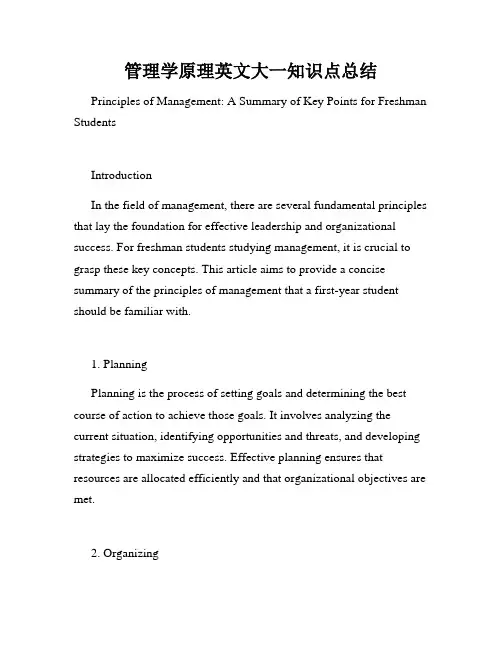
管理学原理英文大一知识点总结Principles of Management: A Summary of Key Points for Freshman StudentsIntroductionIn the field of management, there are several fundamental principles that lay the foundation for effective leadership and organizational success. For freshman students studying management, it is crucial to grasp these key concepts. This article aims to provide a concise summary of the principles of management that a first-year student should be familiar with.1. PlanningPlanning is the process of setting goals and determining the best course of action to achieve those goals. It involves analyzing the current situation, identifying opportunities and threats, and developing strategies to maximize success. Effective planning ensures that resources are allocated efficiently and that organizational objectives are met.2. OrganizingOrganizing involves arranging resources and tasks in a structured manner to achieve the planned goals. This includes determining the division of labor, establishing reporting relationships, and developing a hierarchy of authority. Organizational structure helps to clarify roles and responsibilities, facilitates coordination, and promotes efficiency within the organization.3. LeadingLeading is the process of influencing and motivating individuals to work towards achieving the organization's goals. It involves effective communication, inspiring and empowering employees, and providing guidance and support. Good leadership fosters employee engagement and helps create a positive work environment that promotes productivity and innovation.4. ControllingControlling involves monitoring performance, comparing it with established standards, and taking corrective action if necessary. This process ensures that activities are carried out according to the plans and that organizational objectives are being achieved. It includes setting performance standards, measuring actual performance, and implementing necessary corrections to maintain progress and meet targets.5. Decision-MakingDecision-making is a vital management skill that involves identifying and selecting the best alternative from several possible options. Managers use problem-solving techniques, gather relevant information, and evaluate potential risks and benefits before making decisions. Effective decision-making leads to better outcomes and contributes to the overall success of the organization.6. Human Resource ManagementHuman resource management encompasses activities related to acquiring, developing, and retaining employees. It includes recruitment, selection, training, performance appraisal, and compensation. Managing human resources effectively ensures that the organization has the right people with the required skills and knowledge to achieve its objectives.7. CommunicationCommunication is a critical aspect of management as it facilitates the exchange of information, ideas, and feedback within the organization. Effective communication enhances coordination, builds trust, resolves conflicts, and fosters a culture of transparency and collaboration. Managers should possess excellent communication skillsto effectively convey messages and build strong relationships with employees and stakeholders.ConclusionThese principles of management provide a solid foundation for understanding the fundamentals of effective leadership and organizational success. Freshman students studying management should familiarize themselves with these key concepts as they form the basis for more advanced and specialized management courses in the future. By applying these principles in their future careers, they can become effective managers and contribute to the growth and prosperity of their organizations.。
管理学原理英文Principles of Management: An OverviewIntroduction:The field of management is focused on guiding and directing organizations towards achieving their goals and objectives. In this article, we will explore the fundamental principles of management that help in understanding and effectively applying management practices.1. Planning:Planning involves setting organizational goals and devising strategies to achieve them. It involves identifying the tasks that need to be accomplished, assigning timelines, and allocating resources accordingly.2. Organizing:Organizing focuses on structuring the organization in a way that enables efficient workflow. This includes determining roles and responsibilities, establishing reporting relationships, and creating communication channels.3. Leading:Leading entails influencing and motivating employees to work towards achieving organizational goals. Effective leadership involves providing guidance, support, and inspiration toindividuals and teams.4. Controlling:Controlling involves monitoring and evaluating progress towards objectives. It requires establishing performance standards, measuring actual results, and taking corrective actions when necessary.5. Decision Making:Decision making is a crucial aspect of management. Managers are required to make informed choices based on available information, considering the potential risks and benefits involved.6. Communication:Effective communication is essential for successful management. Managers need to convey information clearly, listen to employees' concerns, and foster open dialogue within the organization.7. Human Resource Management:Managing human resources involves attracting, developing, and retaining the right talent for the organization. This includes recruitment, training, performance evaluation, and employee motivation.8. Ethical Considerations:Ethics play a vital role in management. Managers should adhere to ethical standards and ensure fair treatment of employees, customers, and stakeholders. This builds trust and boosts the organization's reputation.Conclusion:The principles of management provide a foundation for effective organizational management. By understanding and applying these principles, managers can enhance the efficiency and productivity of their teams while achieving organizational objectives.。
管理学原理英文IntroductionPrinciples of ManagementManagement principles are fundamental concepts, theories, and guidelines that help individuals and organizations effectively manage and coordinate activities to achieve goals. These principles, often developed through research and practical experience, provide a framework for decision-making and improve overall organizational performance.1. PlanningThe planning principle involves setting organizational goals and developing strategies and action plans to achieve them. It includes analyzing the internal and external environment, identifying opportunities and threats, and designing effective strategies that align with the organization's mission and vision.2. OrganizingOrganizing involves determining how tasks and resources are to be allocated within the organization. This principle focuses on establishing the structure of the organization, including defining the roles and responsibilities of employees, establishing reporting relationships, and creating systems and processes to coordinate activities and achieve goals.3. StaffingStaffing is the principle that focuses on acquiring and retaining qualified employees to fill positions within the organization. This involves attracting suitable candidates, selecting the best fit for each role, orienting and training new employees, and continuously developing and motivating the workforce to maximize productivity and achieve organizational objectives.4. LeadingLeading involves guiding and motivating employees to accomplish organizational goals. This principle encompasses aspects such as effective communication, inspiring and influencing others, resolving conflicts, and providing feedback and support to encourage high performance and maintain employee engagement.5. ControllingThe controlling principle ensures that organizational activities are aligned with plans and objectives. It involves monitoring performance, comparing actual results to desired outcomes, and taking corrective actions when necessary. Controlling helps in maintaining standards, reducing deviations, and improving overall efficiency and effectiveness.ConclusionUnderstanding and applying management principles is essential for effective management and organizational success. These principles provide a foundation for making informed decisions, creating aproductive work environment, and achieving strategic objectives. By using these principles, managers can address challenges, optimize resources, and achieve sustainable growth for their organizations.。
管理学原理的计划的讲稿Management principles are fundamental guidelines for effective decision making and organizational behavior. These principles provide a framework for understanding the dynamics of management and offer insights into how to effectively lead and manage in various situations.管理学原理是有效决策和组织行为的基本指导方针。
这些原则为理解管理动态提供了框架,并提供了在各种情况下有效领导和管理的见解。
One of the key principles in management is planning. Planning involves setting goals, defining strategies, and outlining the steps to achieve those goals. It is a fundamental activity that helps organizations navigate the complexities of the business environment and chart a course for success.管理的一个关键原则是规划。
规划涉及设定目标、制定战略,并概述实现这些目标的步骤。
这是一项基本活动,有助于组织应对复杂的商业环境,并为成功制定路线。
Effective planning requires a clear understanding of the organization's mission, vision, and strategic objectives. This understanding provides the foundation for developing plans that are aligned with the organization's overall direction and purpose. It also helps in aligning the efforts of various departments and teams towards a common goal.有效的规划需要对组织的使命、愿景和战略目标有清晰的理解。